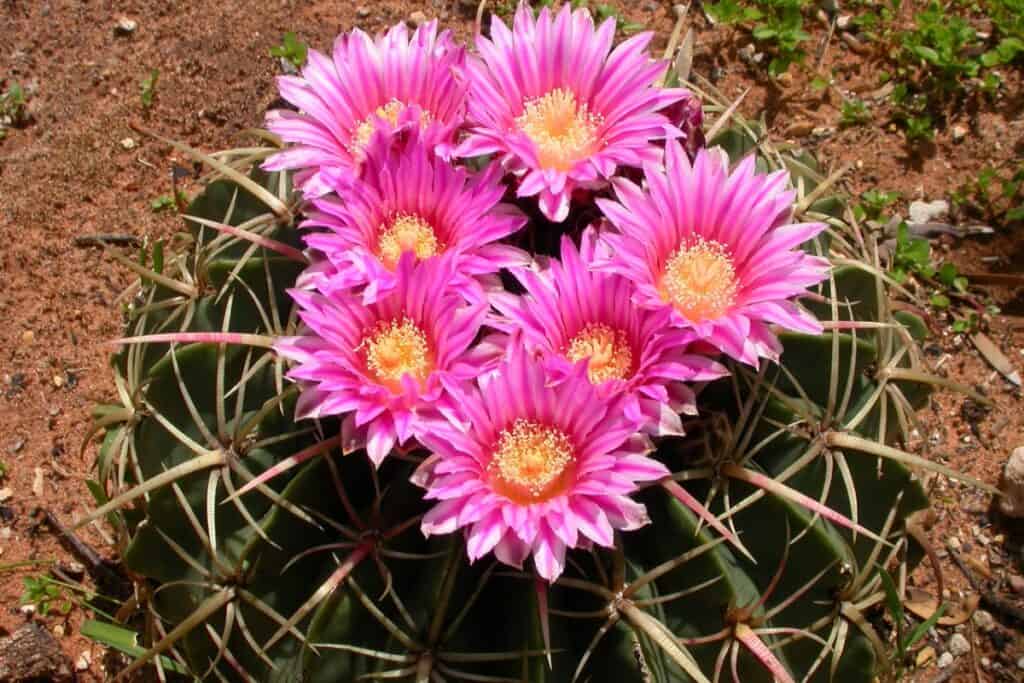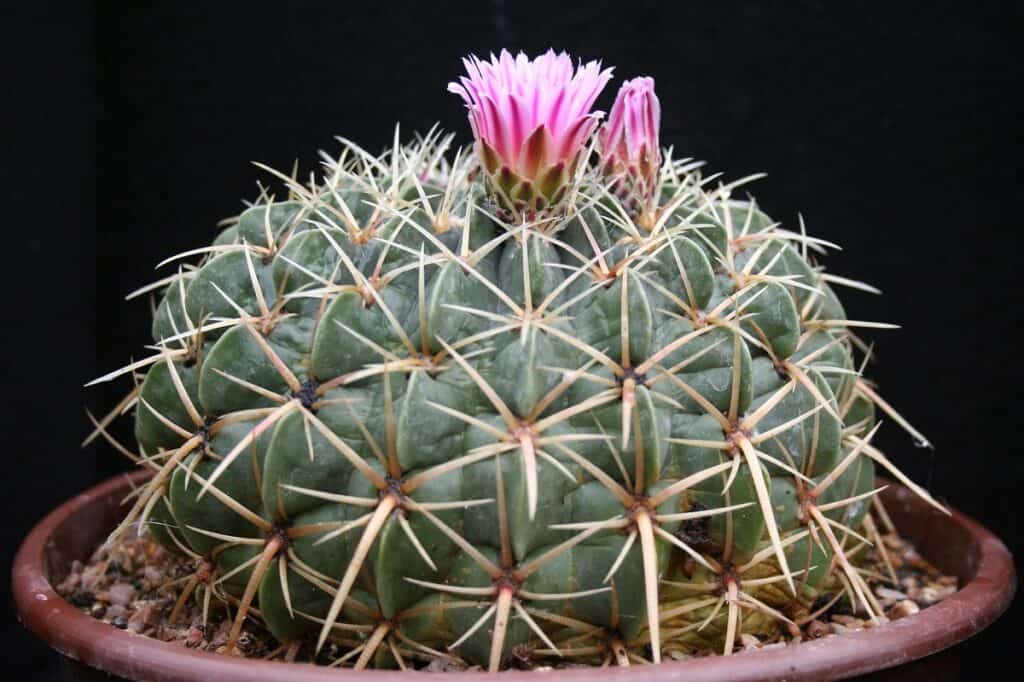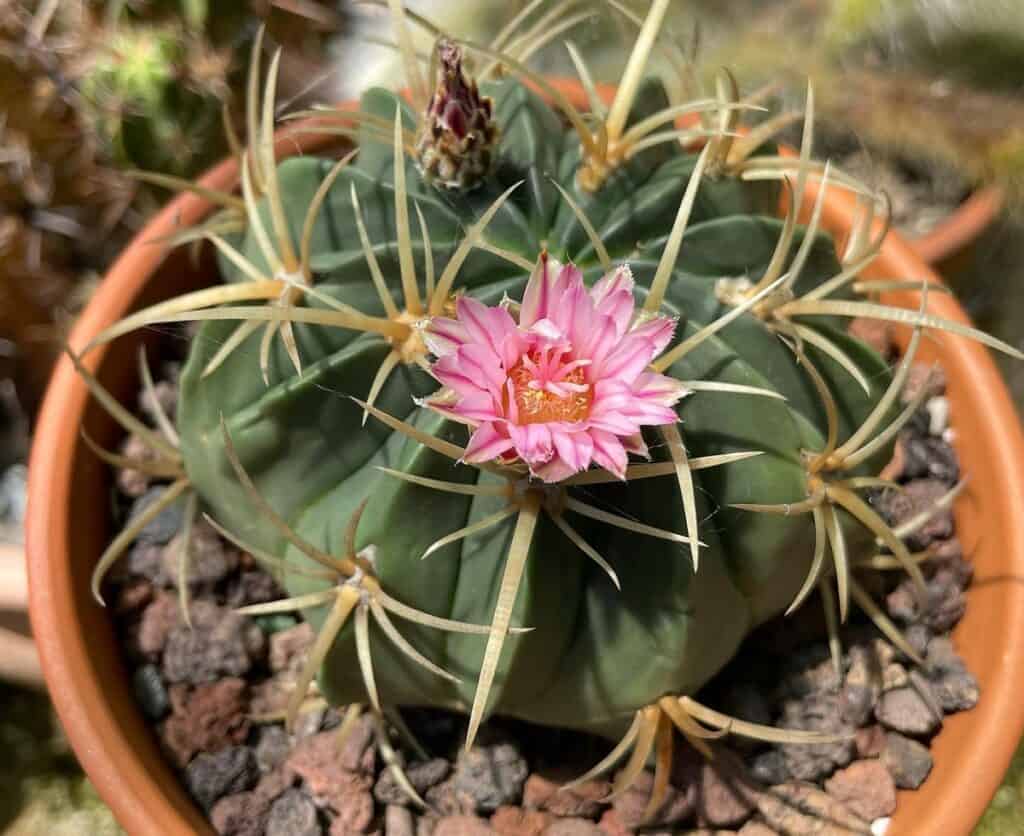Grow Ferocactus macrodiscus – The Precocious Pink-Flowered Cactus
You know those teenage plants that can’t wait to show off their flowers? Well, meet Ferocactus macrodiscus – the cactus that just can’t contain its blossoming excitement! This cute little barrel cactus from Mexico starts flowering when it’s just a few inches tall. Talk about being an over-achiever!
With its saucer-shaped body and funky blue-green skin, F. macrodiscus is already a head-turner. But then it goes the extra mile with striped pink-purple petals that burst open in spring and summer. Like a party hat on top of the weird cactus kid at the dance!
If you’re looking to add some precocious pizzazz to your plant fam, this might just be the perfect weirdo. Let’s dive into the deets on growing this quirky cactus.

Contents
About Ferocactus macrodiscus
This medium-sized barrel cactus has a depressed globe shape up to 1-2 feet tall and wide. It sports 13-35 flattened ribs covered in areoles with yellow felt. The spines range from yellow to red, with 6-8 curvy radial spines and 1-4 stouter central spines up to 4 inches long.
The real showstoppers are the obconic flowers, about 3-4 inches long and wide. Those bright pink petals with pale margins are a definite thirst trap for cactus fans! Plants flower readily from a very young age, which is a rarity among ferocacti.
Related Post:
44 Types of Ferocactus Cacti [With Pictures]
How to Care For Ferocactus macrodiscus
Light Needs
Ferocactus macrodiscus is a full sun-worshipping beach bum. It wants as much bright, direct light as you can give it year-round. During winter’s gloomy days, supplement with a grow light to keep it perky.
Just be careful of scorching if you have it outdoors – ease it into more intense sun exposure gradually. And avoid getting the body wet when the sun is blazing or you risk nasty sunburns.
Watering Needs
In the wild, this cactus deals with periods of drought by storing water in its plump stem. At home, let the soil dry out completely between waterings from spring through fall during the growing period. Give it a long drink, but don’t leave it soaking.
In winter when it’s dormant, cut back considerably on water to just a tiny sip once a month or so. Too much moisture while it’s resting can cause rot.

Soil Situation
Like a moody teen, F. macrodiscus wants a well-drained soil mix that stays on the drier side. A basic cactus & succulent potting mix will work, or make your own by combining:
- 2 parts potting compost
- 2 parts coarse sand
- 1 part perlite or pumice
Whatever you use, good drainage is key! Add a layer of pebbles in the bottom of the pot to further increase air flow.
Feeding Time
Ferocactus aren’t heavy feeders, so a single application of a balanced, extended-release fertilizer in early spring is plenty. Go lightly – just a small handful mixed into the soil.
You can also top-dress with a thin layer of compost as added nutrition. But no need to get crazy with supplements for this low-maintenance kid.
Temperature & Humidity
Desert native = hates cold and moisture! Ferocactus macrodiscus likes it hot and dry. Night temps above 50°F and days in the 70s-90s°F keep it happiest.
Protect it from frost, which can cause irrevocable scarring. High humidity is also a no-go as it increases disease risk. A bright, warm spot with great air flow is ideal.

Pests & Problems
The main pests to watch for are typical cactus culprits like spider mites or mealybugs. An occasional dish soap spray will dislodge most unwanted critters.
Rot from overwatering or poorly draining soil is the biggest threat though. Prevent this by ensuring the plant isn’t sitting in moisture and the pot has adequate drainage holes.
Pruning Needs
Thanks to its naturally compact form, Ferocactus macrodiscus rarely needs pruning beyond removing any dead or diseased sections. Use a sharp, sterilized knife and let the wounds dry before re-potting.
Potting & Repotting
Being a relatively slow-grower, F. macrodiscus can stay pot-bound for several years before needing to move up a container size. When you do repot, go up just 2 inches and do it in spring.
How to Propagate Ferocactus macrodiscus
Ferocactus macrodiscus is one of the easier cacti to propagate from cuttings. You’ll get an extra plant for free – score! Here’s how to do it:
- Take a cutting from the main stem, allowing it to callus over for a few days before planting.
- Prepare a fresh well-draining cactus soil mix.
- Plant the cutting about 1 inch deep, gently firming the soil around it.
- Place in a warm, bright spot but avoid direct sun at first.
- Don’t water for 1-2 weeks to allow the cutting to root.
- After that, water sparingly when the soil is completely dry.
It may take several months for roots to develop fully. Be patient – these funny cacti move at their own precocious pace! Once established, the new plant can be watered and cared for like the parent.
You can also try growing Ferocactus macrodiscus from seeds, but cuttings tend to be faster and more fool-proof.
